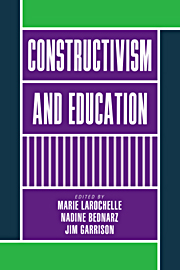Book contents
- Frontmatter
- Contents
- Preface
- List of contributors
- I Introduction
- II From epistemological constructivism to teaching: a variety of views
- III Teaching within the constructivist mode: practices and promises
- 5 Individual construction, mathematical acculturation, and the classroom community
- 6 The construction of answers to insoluble problems
- 7 Voice and perspective: hearing epistemological innovation in students' words
- 8 Constructivism-in-action: students examine their idea of science
- 9 Constructivism and ethical justification
- 10 Social studies, trivial constructivism, and the politics of social knowledge
- 11 Practical knowledge and school knowledge: a constructivist representation of education
- IV The mediating role of teachers and teacher education
- V Conclusion
- Notes
- References
- Index
7 - Voice and perspective: hearing epistemological innovation in students' words
Published online by Cambridge University Press: 04 August 2010
- Frontmatter
- Contents
- Preface
- List of contributors
- I Introduction
- II From epistemological constructivism to teaching: a variety of views
- III Teaching within the constructivist mode: practices and promises
- 5 Individual construction, mathematical acculturation, and the classroom community
- 6 The construction of answers to insoluble problems
- 7 Voice and perspective: hearing epistemological innovation in students' words
- 8 Constructivism-in-action: students examine their idea of science
- 9 Constructivism and ethical justification
- 10 Social studies, trivial constructivism, and the politics of social knowledge
- 11 Practical knowledge and school knowledge: a constructivist representation of education
- IV The mediating role of teachers and teacher education
- V Conclusion
- Notes
- References
- Index
Summary
I begin with a story of a fourth-grade classroom in which the teacher sought to introduce students to least common multiples (LCM) using rhythm. Two students were asked to volunteer. The teacher clapped out a steady beat. One student clapped every two beats, and the other clapped every five beats. After a few false starts, they succeeded in holding their rhythms. The class was asked to identify the beat when the children first clapped together. They listened and answered confidently “ten, every ten.” The same exercise was repeated with one child clapping every two beats, while the other clapped every four. The class eagerly called out that “four” was the beat when the two children clapped together. The class tried two and three beats, but the clappers had trouble holding their beats, so, the class decided to break up into groups of five children. In each group, one child kept the steady beat, two children counted the two rhythms, and the other two listened for the unified clap. By then, many of the children had a conjecture for predicting the number of the first unified clap, “you just multiply the numbers together.” Without responding immediately to their conjectures, the teacher posed two tasks to the groups. One task was to predict the outcome with a four-beat and six-beat, and to test their prediction. The other was to use the materials in the room to make a physical representation of their methods, showing all of the previous patterns including the four- and six-beat task.
- Type
- Chapter
- Information
- Constructivism and Education , pp. 104 - 120Publisher: Cambridge University PressPrint publication year: 1998
- 6
- Cited by



